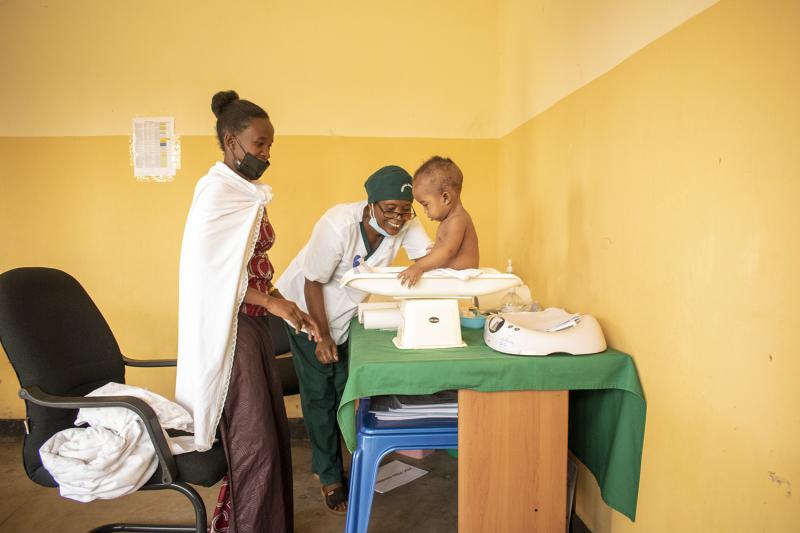Where We Work
See our interactive map


A PDC nurse examines baby Sebastien at Ruhengeri Referral Hospital. Photo by Deogratias Rwangabo Nkurunziza for IntraHealth International.
Thanks to health workers who are now trained to manage birth complications.
The birth of a baby is often a joyous, momentous occasion. For Izabayo Marcel, however, August 2021 was a heartbreaking month. His wife died while giving birth to their baby, Sebastien Duhirwe, and Sebastien suffered from birth asphyxia, which left him fighting for his life.
The doctors and nurses at the Ruhengeri Referral Hospital acted quickly—and their skills saved baby Sebastien.
At-risk infants often don't get optimal support for their health.
Babies such as Sebastien who experience asphyxiated births face greater risk of complications, including cerebral palsy, seizures, paralysis, and slowed mental development. Although advances in technology and greater quality of care have helped more at-risk infants survive the early neonatal period, these infants face more challenges once they leave the hospital and go back to their communities, where they often don’t get optimal support for their health, nutrition, and development. Their chances of survival go down.
To help health workers provide holistic care (including medical, nutritional, and psychosocial support to boost physical and cognitive development of at-risk children), IntraHealth International’s Ingobyi Activity initiated Pediatric Development Clinics (PDCs) in selected health facilities in the Musanze and Rutsiro districts.
Ingobyi used a cascade training approach to train health workers from Ruhengeri and Murunda on the PDC approach and how to implement it, and how to support lower levels of the health system. Ingobyi trained 97 health workers who went on to train other health workers from facilities in their catchment areas. The hospital teams worked with health center providers to establish the PDCs with the Ingobyi Activity, providing the required equipment and materials for each health center.
Sebastien was as the Ruhengeri Referral Hospital PDC. While there, he received continual services, such as family-centered care, nesting, intermittent and continuous Kangaroo Mother Care, and milk fortification.
Marcel also benefitted from the PDC. Since Sebastien’s birth, he has received monthly training and counseling from PDC staff at the hospital on how to take care of Sebastien, including proper nutrition, hypothermia prevention, hygiene, and how to interact with him to boost his cognitive and emotional development. These sessions were crucial for Marcel.
“After my wife died, I didn’t know what to do, how to feed him,” Marcel says. “But when we attended the clinic sessions, I was relieved because the health workers answered a lot of questions on how to raise Sebastien.”
As Sebastien had no mother to breastfeed him, the clinic provided fortified infant formula milk to boost his physical development.
Sebastien has grown into a vibrant, healthy boy.
Now weighing 7.22 kilograms, Sebastien has grown into a vibrant, healthy boy, thanks to the help he received at the clinic.
“When my nephew was born, I didn’t have any hope for him to survive,” says Uwimbabazi Goreth, Sebastien’s aunt. “However, after attending PDC appointments, my hopes were raised. I can’t believe he is this resilient, considering how fragile he looked when he was born.”
Sebastien will continue to receive childhood development services at the PDC until he is two years old.
IntraHealth’s Ingobyi Activity supports PDC services in two hospitals and 26 health centers in the Musanze and Rutsiro districts and aims to scale up the clinics to all supported facilities nationwide.
So far, Ingobyi has trained 48 pediatric development clinic staff for Musanze and 49 for Rutsiro who have cared for 296 at-risk infants, with a 99% survival rate. Some of these infants were born prematurely, while others were born with perinatal asphyxia, failure to thrive, central nervous system infections, or congenital malformation, such as cleft lip, trisomy 21 (or Down syndrome), and hydrocephalus.
Get the latest updates from the blog and eNews




